The Baker Panel Report - ABSA
The Baker Panel Report - ABSA
The Baker Panel Report - ABSA
Create successful ePaper yourself
Turn your PDF publications into a flip-book with our unique Google optimized e-Paper software.
<strong>The</strong> same reports indicate that issues persisted relating to assurance of effective implementation of BP’s HSSE policies and expectations. <strong>The</strong>EEAC reports from 2000 to 2005 highlight the following: inappropriate levels of operational review and maintenance, resource shortage for HSSE, and a lack of regional governance for HSSEissues (report year 2000); audit and assurance program reports and serious incidents indicate that Group HSSE standards were not fully adopted throughoutthe organization (2002 report year); evidence from routine audit programs and serious incidents demonstrate cases of non-compliance with internal policies, standards,and expectations, suggesting suboptimal use of HSSE management systems is reducing effectiveness and safety. <strong>Report</strong> alsoindicates increased emphasis on line management verification of site procedures and processes, and systematic identification andcompletion of agreed actions (2003 report year); consolidated gHSEr audit findings cite to (a) “no material improvement in 2004 on the issue of widespread tolerance of noncompliancewith basic HSE rules,” (b) concern about reliance on key people rather than on established processes of HSSEmanagement system, and (c) overall organizational HSSE capability continues to be a Group risk and includes HSSE leadership andawareness within the senior levels of the Group (2004 report year); and cases of noncompliance with internal standards and controls, inadequate tracking and closure of items, and insufficient sharingwithin segments of gHSEr findings and lessons learned (2005 report year).For additional discussion of gHSEr audit reports and deficiencies cited in those reports, see Section VI.B.<strong>The</strong> same reports to the EEAC raise several other questions about management’s response to continuing issues in safety performance. Forexample, while the 2002 EEAC report indicates that Group HSSE would monitor overdue inspections and loss of containment incidents, thecompany’s performance against those metrics is not discussed in any of the subsequent reports to the EEAC. Although BP appears to haverecognized these metrics as being important indicators of process safety performance, these post-2002 reports to the EEAC do not appear toreflect that BP refining-line management was collecting, reporting, and reviewing this data in a way that allowed BP’s executive managementto give additional consideration to the risks confronting the company and determine whether those risks warranted further managementactions.It also appears that other information about process safety performance, such as repeat process safety audit findings, was not elevated withinthe company. Only in 2006, for example, did BP undertake a review of the previous process safety compliance audits for its U.S. refineries to lookfor indicators of systemic issues.<strong>The</strong> information available to the <strong>Panel</strong> indicates that a substantial gulf appears to have existed between the actual performance of BP’sprocess safety management systems and BP’s perception of that performance. <strong>The</strong> <strong>Panel</strong> appreciates that it reviews the EEAC and gHSErreports with 20/20 hindsight; it also acknowledges that BP management continued to act, year after year, to address the continuing HSSEissues including issues under the HSSE management system. This gulf did not occur at any one particular point in time and did not exist only ata particular point within the organization. Instead, the information available to the <strong>Panel</strong> appears to indicate a more systemic breakdownoccurring at multiple levels and in different line and functional positions. Business units were charged with implementing systems to addresscorporate-level expectations. BP corporate management developed a management framework and high-level expectations, but it did notprovide operational detail or objective criteria for implementation at the refineries. To its credit, BP conducted internal audits and otherassessments that indicated issues existed with the HSSE management system, and BP took a number of steps in an effort to improve processsafety performance.BP’s safety management system was not, however, effective in evaluating whether the actions taken were actually improving the company’sprocess safety performance. <strong>The</strong> company’s lack of process safety performance indicators to measure process safety performance is discussedearlier in this section. For example, during 2002 to 2004—the same time period in which BP was devoting significant resources to developPerformance Evaluation, Corrective Action, and Corporate Oversight C 228

















